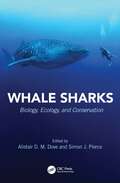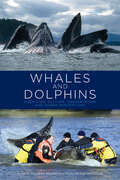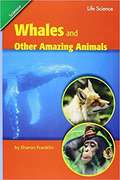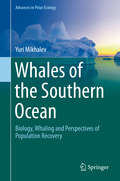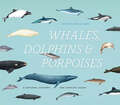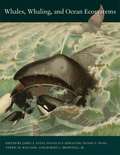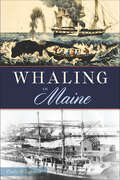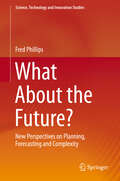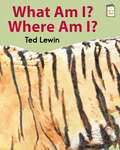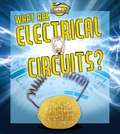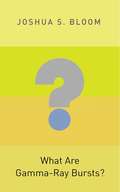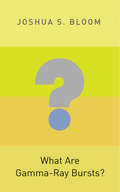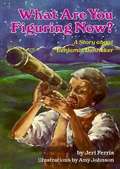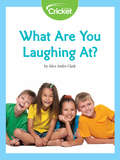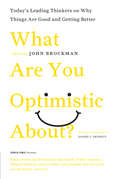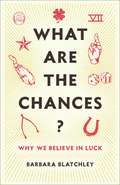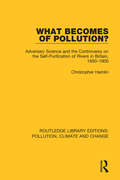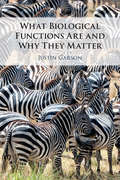- Table View
- List View
Whale Sharks: Biology, Ecology, and Conservation (CRC Marine Biology Series)
by Alistair D. M. Dove Simon J. PierceWhale sharks are the largest of all fishes, fascinating for comparative studies of all manner of biological fields, including functional anatomy, growth, metabolism, movement ecology, behavior and physiology. These gentle ocean giants have captured the interest of scientists and the imagination of the public, yet their future is uncertain. The conservation status of whale sharks was upgraded to Endangered on the IUCN Red List and the species faces a range of intense threats from human activities. Can these iconic living animals, who have survived for millions of years, survive us? Written by the world’s leading experts in whale shark biology, ecology, and conservation, Whale Sharks: Biology, Ecology and Conservation is the first definitive volume about the world's biggest fish. Chapters include discussions of satellite-linked tags, used to track whale shark movements; genetic sequencing, to examine evolutionary adaptations; even the use of underwater ultrasound units to investigate the species’ reproduction. The editors hope that by collating what is known, they can make it easier for future researchers, conservationists, and resource managers to fill some of the remaining knowledge gaps, and provide the information they need to join the team. As you work your way through this book, we hope that you will develop a sense of awe and marvel at all of our good fortune to share the ocean, and the planet, with this utterly extraordinary species.
Whale-watching
by Rob Williams James Higham James Higham Lars Bejder Lars BejderWithin little more than a generation, whale-watching has been subject to global industrial development. It has been portrayed by destinations and business operators, and advocated by environmental groups, as a sustainable activity and an alternative to whaling. However, in recent years the sustainability of these activities has increasingly been questioned, as research shows that repeated disturbance by boat traffic can severely disrupt critical behaviours of cetaceans in the wild. Bringing together contributions by international experts, this volume addresses complex issues associated with commercial whale-watching, sustainable development and conservation of the global marine environment. It highlights widely expressed concerns for the failure of policy, planning and management and pinpoints both long-standing and emerging barriers to sustainable practice. Featuring numerous case studies, the book provides critical insights into the diverse socio-cultural, political, economic and ecological contexts of this global industry, highlighting the challenges and opportunities that arise along the pathways to sustainability.
Whales and Dolphins: Cognition, Culture, Conservation and Human Perceptions (Earthscan Oceans)
by Philippa Brakes and Mark Peter SimmondsWhales and dolphins are icons for the conservation movement. They are the most conspicuous ambassadors for entire marine ecosystems and possibly even for the biosphere as a whole. Concurrent with our realisation of impending threats to their environment is a growing scientific understanding of the social and cognitive complexity of many of these species. This book brings together experts in the relevant diverse fields of cetacean research, to provide authoritative descriptions of our current knowledge of the complex behaviour and social organization of whales and dolphins. The authors consider this new information in the context of how different human cultures from around the world view cetaceans and their protection, including attitudes to whaling. They show how new information on issues such as cetacean intelligence, culture and the ability to suffer, warrants a significant shift in global perceptions of this group of animals and how these changes might be facilitated to improve conservation and welfare approaches.
Whales and Other Amazing Animals: Leveled Reader Grade 3. 3. 4 Advanced
by Sharon FranklinThe third installment of the Reading Street series, Grade 3, delivers structured content designed for children who have a firm foundation in English and Language Arts and are ready to continue on the path to lifelong reading. This curriculum for homeschooling brings together classic reading selections, fun activities and parent/teacher guides to help you develop lessons that boost your student's English and Language Arts learning. As with all levels of Reading Street, Grade 3 was created using educational research to ensure your child is guided through his or her work by age-appropriate and cutting-edge content. <P><P>Each week, your child will work through a series of reading and writing activities that center around a Big Idea. This structure supports your child's critical thinking skills and ensures he or she builds knowledge suitable for a child in third Grade.
Whales of the Southern Ocean: Biology, Whaling and Perspectives of Population Recovery (Advances in Polar Ecology #5)
by Yuri MikhalevBased on actual data of Soviet whaling, and reliable methodologies that existed at the time when this monograph was written, it examines the distribution and migration patterns of whales of the Southern Ocean. It defines distinct populations on the basis of phenes, as well as whale breeding zones, which are located in the adjacent to the Southern Ocean waters at lower latitudes. The book records the presence of a new species of killer whale in the Southern Ocean - Orcinus nana. Prenatal growth patterns, pregnancy and lactation duration, mean sizes of new-born whales are determined. Methods for the graphic recording of registering structures are described, and an original method for their decoding is proposed to determine animal age. The age of sexual and physical maturity, life expectancy is determined. Earlier unknown “pair formations” on the lower jaw of baleen whales and sperm whales are described, together with their macro, histological and electronic microscopic structure.The impact of the extermination of whales on the Southern Ocean ecosystem is examined, recommendations for control of the current state of whale populations are given, and perspectives of whale population recovery are estimated. Regions that could be used as testing areas for whale registration method are defined. The book is intended for biologist-cytologists, ecologists and other specialists interested in cetaceans, and for biology students.
Whales of the World
by W. Nigel BonnerInformative and readable survey of the cetacean species; clear, accurate, and uncomplicated by excessive technical terminology.
Whales, Dolphins & Porpoises: A Natural History and Species Guide
by Annalisa BertaThe eighty-nine cetacean species that swim our seas and rivers are as diverse as they are intelligent and elusive, from the hundred-foot-long, two-hundred-ton blue whale to the lesser-known tucuxi, ginkgo-toothed beaked whale, and diminutive, critically endangered vaquita. The huge distances these highly migratory creatures cover and the depths they dive mean we catch only the merest glimpses of their lives as they break the surface of the water. But thanks to the marriage of science and technology, we are now beginning to understand their anatomy, complex social structures, extraordinary communication abilities, and behavioral patterns. In this beautifully illustrated guide, renowned marine mammalogist Annalisa Berta draws on the contributions of a pod of fellow whale biologists to present the most comprehensive, authoritative overview ever published of these remarkable aquatic mammals. Opening with an accessible rundown of cetacean biology—including the most recent science on feeding, mating, and communication—Whales, Dolphins, and Porpoises then presents species-specific natural history on a range of topics, from anatomy and diet to distribution and conservation status. Each entry also includes original drawings of the species and its key identifiers, such as fin shape and color, tooth shape, and characteristic markings as they would appear both above and below water—a feature unique to this book. Figures of myth and—as the debate over hunting rages on—figures of conflict since long before the days of Moby-Dick, whales, dolphins, and porpoises are also ecologically important and, in many cases, threatened. Written for general enthusiasts, emergent cetacean fans, and biologists alike, this stunning, urgently needed book will serve as the definitive guide for years to come.
Whales, Whaling, and Ocean Ecosystems
by Terrie M. Williams Douglas P. Demaster Daniel F. Doak Robert L. Brownell Jr. James A. EstesThis unprecedented volume presents a sweeping picture of what we know about the natural history, biology, and ecology of whales in the broad context of the dynamics of ocean ecosystems. Innovative and comprehensive, the volume encompasses multiple points of view to consider the total ecological impact of industrial whaling on the world's oceans. Combining empirical research, ecological theory and modeling, and historical data, its chapters present perspectives from ecology, population biology, physiology, genetics, evolutionary history, ocean biogeography, economics, culture, and law, among other disiplines. Throughout, contributors investigate how whaling fundamentally disrupted ocean ecosystems, examine the various roles whales play in food webs, and discuss the continuing ecological chain reactions to the depletion of these large animals. In addition to reviewing what is known of the current and historic whale populations, Whales, Whaling, and Ocean Ecosystems considers how this knowledge will bear on scientific approaches to conservation and whaling in the future and provocatively asks whether it is possible to restore ocean ecosystems to their pre-whaling condition.
Whaling Season: A Year in the Life of An Arctic Whale Scientist (Scientists in the Field)
by Peter LourieIt's late April in Barrow, Alaska, which is about as far north in Alaska as you can get. The call comes in over the two-way radio - a crew has caught the first whale of the spring whaling season. Men, women, and teenagers jump on snow machines and drive out onto the ice to help harvest the whale, a tradition the Inupiaq Eskimos on Alaska's North Slope have followed for over two thousand years. John Craighead George, or Craig as he's called, heads out too. He is an Arctic whale scientist, and out on the ice with the whales and the whalers is just one of the places where an Arctic whale scientist works. <p><p> He and his colleagues have an agreement with the Inupiat to study these whales, bowheads. He has studied them for nearly thirty years and the mysteries of these large creatures never fail to amaze him. This installment in the Scientists in the Field series takes readers along with Craig, his wife, their colleages, and the Inupiat people as they go out on the ice and harvest whales. Lourie also details the happenings in Craig's ramshackle lab where he studies various organs and body parts, takes careful measurements, and crunches numbers. This is a real profile of what it is like to be a scientist living where he works, harvesting his own subjects, and using information passed down from generations of Eskimo culture to help him as he becomes the world's leading expert on bowhead whales. <p><p> Craig George is the son of legendary children's author Jean Craighead George, and it is easy to see that Craig grew up in a household where nature and human interaction went hand in hand. Author Pete Lourie's stunning photographs will transport readers to the top of the world, where the days and nights are long, the people respectful, and the whales are at the center of it all.
Whaling in Maine
by Charles H. LagerbomThe history of American whaling is most frequently associated with Nantucket, New Bedford and Mystic. However, the state of Maine also played an integral part in the development and success of this important industry. The sons of Maine became whaling captains, whaling crews, inventors, investors and businessmen. Towns along the coast created community-wide whaling and sealing ventures, outfitted their own ships and crewed them with their own people. The state also supplied the growing industry with Maine-built ships, whale boats, oars and other maritime supplies. For more than two hundred years, the state forged a strong and lasting connection with the American whaling industry. Author and historian Charles Lagerbom reveals why Maine should rightly take its place alongside its more well-known New England whaling neighbors.
What About the Future?: New Perspectives on Planning, Forecasting and Complexity (Science, Technology and Innovation Studies)
by Fred PhillipsThis book closely examines the concept and theory of 'future' from a multidisciplinary perspective, focusing on the practice of forecasting, especially in its interaction with complexity. It highlights the relations between forecasting, decision-making and strategy, mixing technical arguments (but minimal mathematics) with ideas from psychology and philosophy. Rich with examples, the book highlights the role of values and attitudes in deciding how to look at the future. Written in a casual but precise style that makes the ideas easily digestible, it helps corporate strategists, practicing futurists, and researchers in the field of strategy or public planning gain a fundamental perspective on the future – before starting to predict things.
What Am I Made Of?
by David BennettCan anyone explain the human anatomy to a child in such a pleasingly simple and enjoyable style? This book does it!
What Am I? Where Am I? (I Like to Read)
by Ted LewinMajestic paintings by Caldecott Honor winner Ted Lewin illustrate a guessing game that fosters an appreciation of both art and science, while introducing animals in the five major biomes: grassland, desert, forest, tundra, and water. Inspired by his many travels, classically inspired compositions communicate the regal magnificence of five stunning animals: lion, camel, tiger, reindeer, and sea otter. The story ends with a painting of a child and text that reads: I am a boy. I am on the beautiful earth. An I LIke to Read(R) book. Guided Reading Level C.
What Are Electrical Circuits? (Understanding Electricity)
by Ronald MonroeThis comprehensive title introduces readers to current electricity and circuits, the pathways through which electricity flows. Supportive text explains the basic components of an electric circuit and the functions of these parts. Through real-life examples and opportunities for hands-on learning, readers understand and construct simple open, closed, parallel, and series circuits.
What Are Gamma-Ray Bursts?
by Joshua S BloomGamma-ray bursts are the brightest--and, until recently, among the least understood--cosmic events in the universe. Discovered by chance during the cold war, these evanescent high-energy explosions confounded astronomers for decades. But a rapid series of startling breakthroughs beginning in 1997 revealed that the majority of gamma-ray bursts are caused by the explosions of young and massive stars in the vast star-forming cauldrons of distant galaxies. New findings also point to very different origins for some events, serving to complicate but enrich our understanding of the exotic and violent universe. What Are Gamma-Ray Bursts? is a succinct introduction to this fast-growing subject, written by an astrophysicist who is at the forefront of today's research into these incredible cosmic phenomena. Joshua Bloom gives readers a concise and accessible overview of gamma-ray bursts and the theoretical framework that physicists have developed to make sense of complex observations across the electromagnetic spectrum. He traces the history of remarkable discoveries that led to our current understanding of gamma-ray bursts, and reveals the decisive role these phenomena could play in the grand pursuits of twenty-first century astrophysics, from studying gravity waves and unveiling the growth of stars and galaxies after the big bang to surmising the ultimate fate of the universe itself. What Are Gamma-Ray Bursts? is an essential primer to this exciting frontier of scientific inquiry, and a must-read for anyone seeking to keep pace with cutting-edge developments in physics today.
What Are Gamma-Ray Bursts?
by Joshua S. BloomGamma-ray bursts are the brightest--and, until recently, among the least understood--cosmic events in the universe. Discovered by chance during the cold war, these evanescent high-energy explosions confounded astronomers for decades. But a rapid series of startling breakthroughs beginning in 1997 revealed that the majority of gamma-ray bursts are caused by the explosions of young and massive stars in the vast star-forming cauldrons of distant galaxies. New findings also point to very different origins for some events, serving to complicate but enrich our understanding of the exotic and violent universe. What Are Gamma-Ray Bursts? is a succinct introduction to this fast-growing subject, written by an astrophysicist who is at the forefront of today's research into these incredible cosmic phenomena. Joshua Bloom gives readers a concise and accessible overview of gamma-ray bursts and the theoretical framework that physicists have developed to make sense of complex observations across the electromagnetic spectrum. He traces the history of remarkable discoveries that led to our current understanding of gamma-ray bursts, and reveals the decisive role these phenomena could play in the grand pursuits of twenty-first century astrophysics, from studying gravity waves and unveiling the growth of stars and galaxies after the big bang to surmising the ultimate fate of the universe itself. What Are Gamma-Ray Bursts? is an essential primer to this exciting frontier of scientific inquiry, and a must-read for anyone seeking to keep pace with cutting-edge developments in physics today.
What Are You Figuring Now? A Story about Benjamin Banneker
by Jeri Chase FerrisA biography of the Afro-American farmer and self-taught mathematician, astronomer, and surveyor for the new capital city of the United States in 1791, who also calculated a successful almanac notable for its preciseness.
What Are You Laughing at?
by Alice Andre-ClarkHumans are such experts at laughing that we can distinguish a fake laugh from a real one. But why do we laugh?
What Are You Optimistic About?
by John BrockmanThe nightly news and conventional wisdom tell us that things are bad and getting worse. Yet despite dire predictions, scientists see many good things on the horizon. John Brockman, publisher of Edge (www.edge.org), the influential online salon, recently asked more than 150 high-powered scientific thinkers to answer a vital question for our frequently pessimistic times: "What are you optimistic about?" Spanning a wide range of topics-from string theory to education, from population growth to medicine, and even from global warming to the end of world-What Are You Optimistic About? is an impressive array of what world-class minds (including Nobel Laureates, Pulitzer Prize winners, New York Times bestselling authors, and Harvard professors, among others) have weighed in to offer carefully considered optimistic visions of tomorrow. Their provocative and controversial ideas may rouse skepticism, but they might possibly change our perceptions of humanity's future.
What Are You Optimistic About?
by Mr John BrockmanThe nightly news and conventional wisdom tell us that things are bad and getting worse. Yet despite dire predictions, scientists see many good things on the horizon. John Brockman, publisher of Edge (www.edge.org), the influential online salon, recently asked more than 150 high-powered scientific thinkers to answer a vital question for our frequently pessimistic times: "What are you optimistic about?"Spanning a wide range of topics--from string theory to education, from population growth to medicine, and even from global warming to the end of world--What Are You Optimistic About? is an impressive array of what world-class minds (including Nobel Laureates, Pulitzer Prize winners, New York Times bestselling authors, and Harvard professors, among others) have weighed in to offer carefully considered optimistic visions of tomorrow. Their provocative and controversial ideas may rouse skepticism, but they might possibly change our perceptions of humanity's future.
What Are You Optimistic About?
by Mr John BrockmanThe nightly news and conventional wisdom tell us that things are bad and getting worse. Yet despite dire predictions, scientists see many good things on the horizon. John Brockman, publisher of Edge (www.edge.org), the influential online salon, recently asked more than 150 high-powered scientific thinkers to answer a vital question for our frequently pessimistic times: "What are you optimistic about?"Spanning a wide range of topics--from string theory to education, from population growth to medicine, and even from global warming to the end of world--What Are You Optimistic About? is an impressive array of what world-class minds (including Nobel Laureates, Pulitzer Prize winners, New York Times bestselling authors, and Harvard professors, among others) have weighed in to offer carefully considered optimistic visions of tomorrow. Their provocative and controversial ideas may rouse skepticism, but they might possibly change our perceptions of humanity's future.
What Are the Chances?: Why We Believe in Luck
by Barbara BlatchleyMost of us, no matter how rational we think we are, have a lucky charm, a good-luck ritual, or some other custom we follow in the hope that it will lead to a good result. Is the idea of luckiness just a way in which we try to impose order on chaos? Do we live in a world of flukes and coincidences, good and bad breaks, with outcomes as random as a roll of the dice—or can our beliefs help change our luck?What Are the Chances? reveals how psychology and neuroscience explain the significance of the idea of luck. Barbara Blatchley explores how people react to random events in a range of circumstances, examining the evidence that the belief in luck helps us cope with a lack of control. She tells the stories of lucky and unlucky people—who won the lottery multiple times, survived seven brushes with death, or found an apparently cursed Neanderthal mummy—as well as the accidental discoveries that fundamentally changed what we know about the brain. Blatchley considers our frequent misunderstanding of randomness, the history of luckiness in different cultures and religions, the surprising benefits of magical thinking, and many other topics. Offering a new view of how the brain handles the unexpected, What Are the Chances? shows why an arguably irrational belief can—fingers crossed—help us as we struggle with an unpredictable world.
What Becomes of Pollution?: Adversary Science and the Controversy on the Self-Purification of Rivers in Britain, 1850-1900 (Modern European History Ser.)
by Christopher HamlinOriginally published in 1987, this volume examines the ideals and realities of river use in 19th Century Britain and the failure of legal and technological remedies for river pollution. It deals with the involvement of scientists, particularly chemists, in pollution inquiries and considers the effects on the normal workings of the scientific community of scientists’ participation in the adversary forums in which water and sewage policy was made. It discusses 19th ideas of decomposition, disease causation and purification and examines the gap between the abilities of science and the needs of society that developed as the existence of water-borne disease became increasingly clear. It also deals with the politicization of water bacteriology and the emergence of a technology of biological sewage treatment from a political context.
What Biological Functions Are and Why They Matter
by Justin GarsonThe biological functions debate is a perennial topic in the philosophy of science. In the first full-length account of the nature and importance of biological functions for many years, Justin Garson presents an innovative new theory, the 'generalized selected effects theory of function', which seamlessly integrates evolutionary and developmental perspectives on biological functions. He develops the implications of the theory for contemporary debates in the philosophy of mind, the philosophy of medicine and psychiatry, the philosophy of biology, and biology itself, addressing issues ranging from the nature of mental representation to our understanding of the function of the human genome. Clear, jargon-free, and engagingly written, with accessible examples and explanatory diagrams to illustrate the discussion, his book will be highly valuable for readers across philosophical and scientific disciplines.
